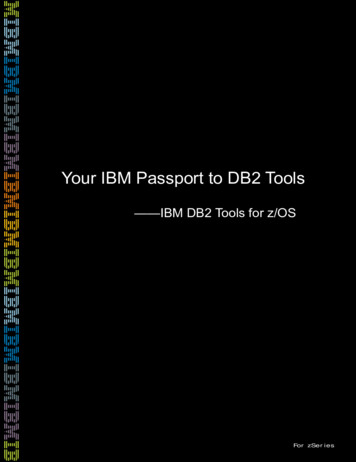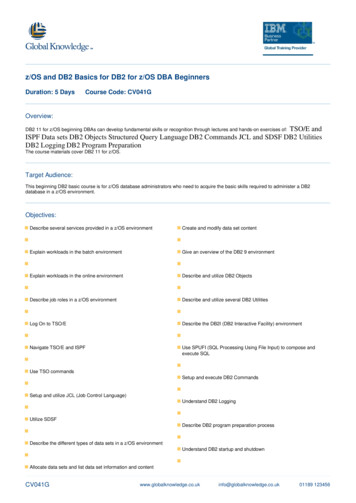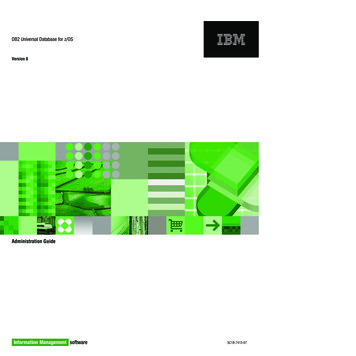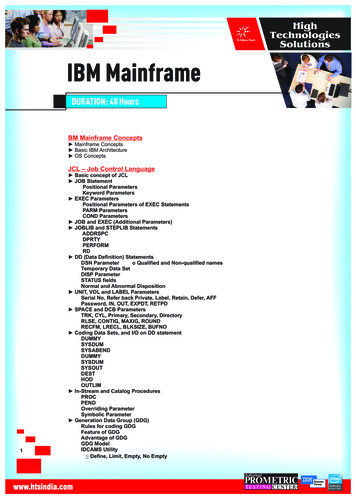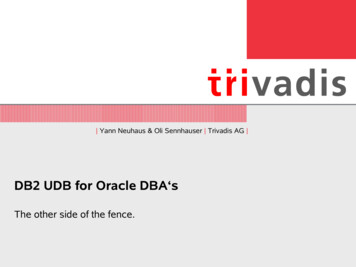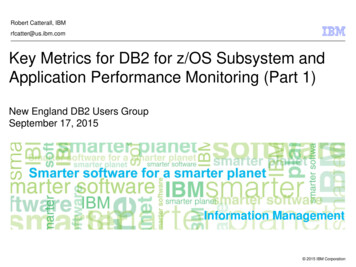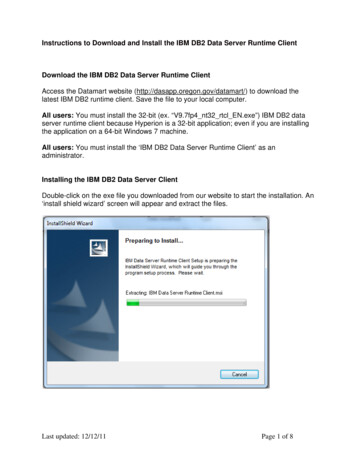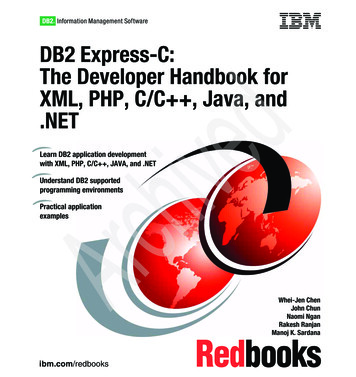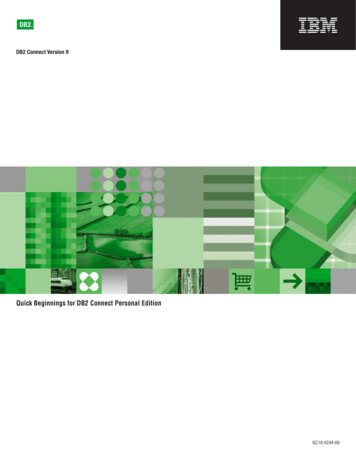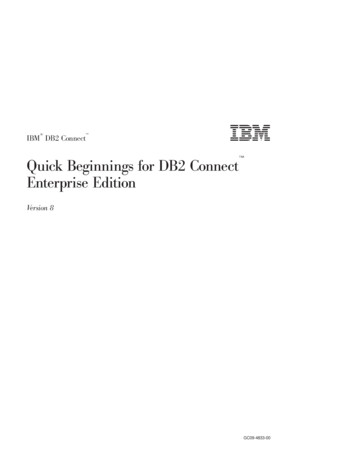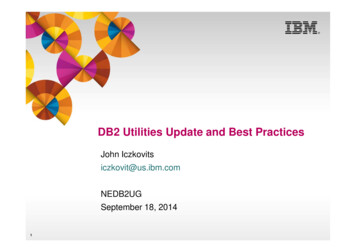
Transcription
DB2 Utilities Update and Best PracticesJohn Iczkovitsiczkovit@us.ibm.comNEDB2UGSeptember 18, 20141
Agenda 2OverviewREORGStatisticsBackup & RecoveryUNLOAD & LOADCompression DictionariesGeneral EnhancementsDeprecationMore informationSummary
Overview: Goal of DB2 Utilities Support core function Reduce CPU, ET & resource consumption Maximize availability Remove constraints & limitations Simplify data management3
Improve performance of part-level REORG with NPSIs New option to defer shadow index build until all keys passedthrough sort New parm & zparm to govern– AUTO/ENABLE/DISABLE options Retrofit to DB2 9 & 10 in PM55051 Result:– Customer test of REORG of 40% of partitions showed 55% ETreduction & 22% CPU increase– DB2 Sort gives additional ET reduction & cuts CPU to less thanoriginal starting point4
SWITCH phase impact relief – reduced application impact Easier drain acquisition Prevent new claims on all targetpartitions while waiting for drainsREORG drain durationand switch time– Faster drain acquisition for partlevel REORGDB2 10 drain durationDB2 10 switch phase New DRAIN ALLPARTS option tomomentarily drain all data parts Restructure SWITCH phaseprocessing for outage reduction– SWITCH phase ET reduction of91% measured when reorging20 parts512001000Seconds– Eliminates claim-drain“deadlocks” for part-levelREORG with NPSIsDB2 11 drain durationDB2 11 switch phase8006004002000010002000Number of partitions30004000
Timing of SWITCH phase with MAXRO DEFER Govern timing of drain and switch for long-running REORGs without theneed to schedule separate –ALTER UTILITY command New SWITCHTIME parameter to determine earliest point at which drainprocessing will be attempted --------------- - ----------------------------- -- -SWITCHTIME- -timestamp-------------------------- ------ --------------------------------- -labeled-duration-expression- -NEWMAXRO-integer--- 6 -NEWMAXRO-NONE--
Physically delete empty PBG partitions Ability for REORG to physically delete empty PBG partitions New zparm REORG DROP PBG PARTS– DISABLE – keep V10 behavior (default)– ENABLE – Delete empty PBG partitions on table space-levelREORG Considerations:– Cannot be specified on REORG statement– If PBG created using NUMPARTS or ALTER ADD partition used,REORG may prune to a lesser number of partitions– No PIT recovery to prior to a pruning REORG No facility to resurrect deleted partitions7
Automated mapping table handling Scalability constraint with existing mapping table index limits # rows that canbe reorged Mapping table DDL must change in 11 due to RBA/LRSN change Requirements to automate mapping tables Solution: New automated mapping tables in REORG– Support mapping tables in PBGs Increases mapping index max size from 64Gb to 16Tb– Retrofitted to V9 in PM58177– Automatically create new format mapping table if required1.2.3.4.5.If mapping table specified & correct format then honor specificationElse if specified but incorrect format then create new in same db as originalElse if not specified and zparm DB specified then create in ZPARM DBElse create in implicit DBDROP at end of REORG or end of last REORG if multiple REORGs in job step– NFM requires new format mapping table 8CM, CM*, ENFM, ENFM* supports old & new format mapping table
REORG without sorting data Increasingly REORGs are performed for reasons other than to regainclustering of data, yet no ability to avoid cost of reclustering REORG SHRLEVEL CHANGE does not support SORTDATA NO Support SORTDATA NO with SHRLEVEL CHANGE New RECLUSTER YES/NO option on SORTDATA NO– RECLUSTER NO – Do not unload data through clustering index and do notsort data records in clustering order9
Partition-level inline image copy Faster partition-level recovery from inline image copy Create partition-level inline image copies if using TEMPLATE with &PA or&PART– No new option or keyword on REORG– PM93611: Support subscripting of &PA as long as subscript ensures uniqueness Support writing to tape as long as STACK YES not specified14 RECOVER of single partition of a 20partition table space1210– ET reduced by 28%8– CPU reduced by d10CPU
Improved REORG LISTDEF Processing PARALLEL YES/NO option introduced in APAR in V9– NO – Prevent REORG from processing multiple partitions in single REORGwhen input is partlevel LISTDEF– Zparm REORG LIST PARALLEL at zparm level Need compromise option for customers who want to take advantage ofREORG parallelism but cannot afford to shadow many partitions at a time New option LISTPARTS n to limit # of partitions to be processed in a singleREORG if input is a part-level LISTDEF Considerations:– PARALLEL YES/NO will be deprecated but still supported in 11– PARALLEL NO LISTPARTS 1– PARALLEL YES No LISTPARTS specification– No REORG LIST PARALLEL n zparm option11
REBALANCE Enhancements Improved availability & failure prevention Support REORG SHRLEVEL CHANGE REBALANCE– Complements online ALTER LIMITKEY Improve resiliency with enhanced distribution algorithm & improvedhandling of empty partitions Build compression dictionary for all partitions– Previously, partitions that were empty at the start of REORG would not have adictionary built, requiring a subsequent REORG to gain compression New SORTCLUSTER option to sort data in clustering as well aspartitioning order to avoid AREO*– Occurred when partitioning key not a superset of clustering key12
REORG of LOB data Support REORG of LOB data even though aux index is unavailable– Problem in V10 if LOB tablespace is REORP and index is RBDP LOBs can’t be reorged and index can’t be rebuilt REORG SHRLEVEL NONE for LOBs changed to RC8 from 11 CMonwards– Not supported in 10 NFM, but returns RC0 with MSGDSNU126I13
Improved REORG serviceability Need ability to use online REORG even when SYSLGRNX cannot be reliedupon Support LOGRANGES NO option for REORG SHRLEVEL CHANGE14
REORG change of defaults to match best practices Change default options:– DRAIN WRITERS to DRAIN ALL– DISCARD to DISCARD NOPAD YES– UNLOAD EXTERNAL to UNLOAD EXTERNAL NOPAD YES15
REORG Best Practices REORG SHRLEVEL CHANGE for maximum availability Use DRAIN ALL rather than DRAIN WRITERS Use TIMEOUT TERM to free up objects on timeouts If minimizing application impact is key:– (DRAIN WAIT MAXRO) (IRLMRWT -5 or 10 secs) for minimalapplication impact– Specify high RETRY value (6 or more) If REORG success in a small window is key:– Consider starting REORG early with MAXRO DEFER then -ALTER UTILITYcommand– High DRAIN WAIT & MAXRO to guarantee REORG success If using REORG DISCARD, use NOPAD for improved performance LOBs:– SHRLEVEL REFERENCE in V9, SHRLEVEL CHANGE in V10– Stop using SHRLEVEL NONE before DB2 10 NFM16
Statistics Enhancements More zIIP offload for RUNSTATS distribution statistics– Up to 80% zIIP-eligible zIIP offload for inline statistics– Additional 30% offload to zIIP Enhance inline statistics for RUNSTATS avoidance– Inline statistics collection on NPSIs during REORG with SORTNPSI– Inline histogram statistics– Inline DSTATS New RUNSTATS RESET option to reset existing statistics Improved PROFILE usability for LISTDEF processing– Gather default statistics if no profile exists for table17
Statistics Enhancements Optimizer determination of missing statistics– Optimizer identifies missing statistics & writes information to new catalog tableDSN STAT FEEDBACK– OQWT modifies statistics profile– Automation Tool detects profile change & builds RUNSTATS job– DSNACCOX similarly enhanced to recommend RUNSTATS -ACCESS DATABASE MODE(STATS) option to externalize RTSstatistics RTS overhead reduction18
Statistics Best Practices Do not use RUNSTATS to gather space statistics – rely onRTS Do not gather unnecessary stats Use sampling, and TABLESAMPLE in DB2 10 Use profiles in DB2 10 and 11 Use inline stats where possible rather than RUNSTATS, butno zIIP for inline stats in DB2 10 Specify KEYCARD prior to DB2 10– Index cardinality stats are cheap to collect and heavily reliedupon by optimizer Don’t bother running RUNSTATS on LOB table spaces– RTS contains all the information you need19
Backup & Recovery Enhancements Faster catalog/directory recovery– Enhanced SYSLGRNX recording New VCAT name translation for RESTORE SYSTEM for system cloning– Support logapply when RESTORE SYSTEM used for cloning purposes Improved recoverability with COPY-REORG concurrency– Permit COPY to run concurrent with long-running REORGs Avoid allocating empty image copy datasets for incremental orCHANGELIMIT copies Lifted many restrictions on PIT recovery prior to materializing REORG– PIT recovery restrictions lifted for LOB, XML and PBR table spaces Including when immediate alters have occurred since materializing REORG– PIT recovery restrictions still in place 20Table space conversionPBG table spacesPBG partition pruningOnline DROP COLUMN
Backup and Recovery Best Practices SHRLEVEL CHANGE unless consistent copies are essential Use PARALLEL keyword to exploit parallelism Consider OPTIONS EVENT(ITEMERROR,SKIP) Sets UTRW state only for duration of copy of individual page set But increases COPY overhead Serialisation required for each pageset on the fly Consider taking incremental copies and using MERGECOPY MERGECOPY marks relevant page set UTRW Copy indexes on large, critical tables Particularly if rarely or never updated Only drawback – increase in SYSLGRNX & SYSCOPY recording Automatically included in MODIFY RECOVERY21
LOAD & UNLOAD Enhancements Crossloader support for XML data Exploit FETCH CONTINUE for processing large LOBs & XML data inCrossloader– Reduce vstor requirement– Avoid DSNU1178i errors– 28% CPU reduction Load of 1Mb LOBs zIIP offload for LOAD REPLACE PART clearing of NPSIs– 100% offload to zIIP for LOAD REPLACE with dummy input22
LOAD & UNLOAD Enhancements LOAD SHRLEVEL NONE PARALLEL with single input dataset– Parallel data conversion– Not supported for PBGs– 50% ET reduction possible on single SYSREC loadConversion 1PartConversion 2InputReadConversion 3SYSRECConversion 41Load taskPart2Conversion 52323
LOAD & UNLOAD Enhancements LOAD SHRLEVEL CHANGE PARALLEL– Supports non-partitioned as well as partitioned– Single input dataset– Not supported for PBGs– 80% ET reductionConversion 1Conversion 2InputSYSRECPart1Read taskConversion 3PartConversion 424242
Load and Unload Best Practices 25Run LOAD with LOG NO, REUSE, KEEPDICTIONARY if possibleUse SORTDEVT to drive parallel index buildAllocate inline copy data sets to DASDSplit up input dataset and drive LOAD partition parallelism in a singleLOADUse SORTNUM eliminationSpecify NUMRECS if input is on tape or variable lengthIf loading partitioned table with single input dataset, presort data inclustering (partitioning) key order– PRESORT option in Utility Enhancement ToolFor LOAD REPLACE, consider loading into a “clone” then renamingtables or datasetsConsider using USS named pipesUse FORMAT INTERNAL, PRESORTED or INDEXDEFER if possible
Compression Dictionaries Avoid decompression failures for IFI 306 readers when new compressiondictionary built by REORG/LOAD Old compression dictionary stored on log New SYSCOPY record written pointing to old compression dictionary forCDC tables IFI 306 read automatically retrieves old compression dictionary if necessary Avoid need for replication target refresh when dictionary changes2626
General Enhancements Greater parallelism for faster utilities– 11% elapsed time reduction measured for REORG, LOAD, REBUILD INDEX PARALLEL option for parallelism control for LOAD, REORG, REBUILD INDEX,UNLOAD, CHECK INDEX -DISPLAY UTILITY enhancements– Remove serialization between –DIS UTIL and –TERM UTIL– Jobname, start timestamp– Late addition: SWITCHTIME and NEWMAXRO Utility impact reduction on bufferpools– Extend MRU for UNLOAD, REORG TABLESPACE, RUNSTATS TABLESPACE,RUNSTATS INDEX, REBUILD INDEX, CHECK INDEX, CHECK DATA Improved dataset cleanup in utility stored procedures– Previously, datasets remained allocated on utility failure, preventing cleanup27
General Enhancements Improved TEMPLATE support for large / EF datasets and local time values– DSNTYPE LARGE, EXTREQ, EXTPREF– New EATTR option on TEMPLATE to request extended attributes– New TIME LOCAL UTC option Enforce NUMTCB 1 for stored procedures DSNACCOX performance400350300250V10 ElapsedV11 Elapsed200150100500DSNACCOX query where DB x28
Deprecation REORG SHRLEVEL NONE for LOBs changed to RC8 from 11 CMonwards– Not supported in 10 NFM, but returns RC0 with MSGDSNU126I Still supported in 11, but no longer documented:– REORG PARALLEL YES NO– Superseded by LISTPARTS INDREFLIMITOFFPOSLIMITLEAFDISTLIMITUNLOAD ONLYUNLOAD PAUSEUNLOAD EXTERNAL– COPY CHANGELIMIT29
Want to learn more about DB2 Utilities? Attend a DB2 Utilities Workshop– What is it? Complimentary (1/2 day ) session with information tohelp gain a better understanding of the features deliveredin the DB2 Utilities Suite for z/OS and how they can be used tomanage your DB2 environment. Topics include– What utility features can save you time and money– Understanding your utility maintenance needs to meet SLAs– What’s the benefit to you? Useful information, materials and contacts help you achieve the maximumbenefits from the features delivered in the DB2 Utilities Suite for z/OS andthey can help manage your utility maintenance to improve your DB2 for z/OScritical applications– Who is it designed for? DBAs/App DBAs, DB2 System Administrators, and Technical Management– Contact your IBM sales rep for more details and schedule30
The Best Practice Tip for DB2 Utilities:“More data,DB2 Utilities Solution Packreduced costs” During DB2 utilities sort processing, reduce CPUusage and elapsed time by up to 50%* Eliminate ALL CPU and elapsed time by avoidingunnecessary utility processing?– Set it and forget it, adjust to fit changing needs Use the fastest and most flexible unload in themarket to modernize your data movement Set company-wide DB2 utility standards–Enforced and auditable ONE change to embedded DB2 Utility JCL canfind and update every occurrence in everyapplication with the most current version of DB2for z/OSOptimize, controlmanage & automateHowWhendousedwe getwiththethebestIBM DB2controlUtilitiesoverDB2Suite,utilityIBM beats orprocessing?matches performancewith every otherHowdo we save3rd party vendor for:CPU & Elapsed timewhile improvingavailability? Using less CPU Reducing ETHow do we do smart More zIIP offloadautomation for DB2utilities execution?DB2 UtilitiesSolutionSolutionPack31* With zIIP engine
General Best Practices Plan your move to DB2 11 to take advantage of the latest inDB2 11 enhancements Stay current on DB2 maintenance as much as possible Attend a DB2 Utilities Workshop Check out the DB2 Utilities Solution Pack to make your DB2utility environment more efficient and easier to manage32
Summary Day-1 support for utilities and utility managementproductsion with core DB2 versions/functions Innovation continuing & delivery pace accelerating Continuous delivery of performance enhancements & features of realbusiness value Eliminate application impact from utilities Reduce elapsed time & CPU consumption Reduce resource consumption Reduce complexity & improve automation -- Build expert knowledgeinto the tools, not just tools for the expert!33
Use sampling, and TABLESAMPLE in DB2 10 Use profiles in DB2 10 and 11 Use inline stats where possible rather than RUNSTATS, but no zIIP for inline stats in DB2 10 Specify KEYCARD prior to DB2 10 - Index cardinality stats are cheap to collect and h eavily relied upon by optimizer Don't bother running RUNSTATS on LOB .
